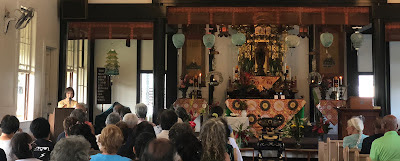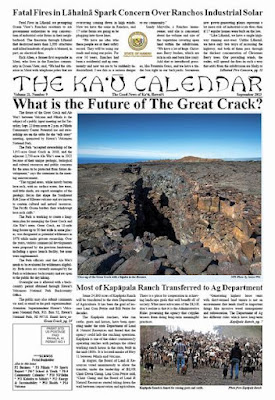 |
| Bon Dancing returns to Pāhala Hongwanji and everyone is invited on Saturday, Sep. 16. Photo by Clement Hirae |
 |
| Hongwanji President Wayne Kawachi and Kiko Ando in Aloha Yutaka designed by Ando. Photo by Minako Yamazaki |
.jpg) |
| The grand bell at Pāhala Hongwanji will watch over Obon Dance to close out this year's Obon season on Saturday, Sept. 16. Photo by Julia Neal |
There will be Pāhala Taiko drumming, dancing in the round with people in traditional costumes circling the tower, with singing, flutes, drums and other music. Everyone is invited to join in the dance, performed by participants from around the island. Also on tap are aikido demonstrations.
The Pāhala Hongwanji Bon Dance will be the last one at Buddhist temples around Hawai‘i island during this Obon season. The Bon Dance honors those who came before, a celebration of the harvest with the presentation of fresh vegetables, fruits and other foods for ancestors on the temple altar.
A traditional Hatsubon service begins at 4 p.m., followed by the dance. Keiki and adults can participate in making traditional, handmade Hachimaki headbands to wear. Food and other refreshments will be available for sale, including maki sushi. Japanese wind charms from Pāhala Hongwanji Taiko will be offered for sale.
Soto Michi Dojo will be open in the old Japanese schoolhouse on the temple grounds with short aikido demos between 6:30 p.m. and 8 p.m., and sensei will be available to talk story about aikido and classes. Dojo members have also volunteered to clean the grounds and direct parking for the event.
This is the first Bon Dance at Pāhala since the Covid pandemic began. The address is 96-1123 Pa‘au‘au Pl., Pāhala.
Explosive eruptions are characterized by their impulsive onset and tend to radiate energy equally in all directions. These types of eruptions may throw rocks in all directions. At Stromboli, sustained jets have longer durations and produce a directed plume of ash and rocks away from the vent. The events are analogous to jet engine dynamics and such volcanic jetting can push ash to heights beyond international airline traffic altitudes.
The Hawaiian Volcano Observatory currently uses UAS techniques to measure volcanic gas and conduct aerial imagery surveys to generate three-dimensional models. Experiments by other volcano scientists show that applications of UAS technology are continuing to develop and expand. If you want to learn more about experiments of this type, please check out this recent publication in Geophysical Research Letters (2023).
The Pāhala Hongwanji Bon Dance will be the last one at Buddhist temples around Hawai‘i island during this Obon season. The Bon Dance honors those who came before, a celebration of the harvest with the presentation of fresh vegetables, fruits and other foods for ancestors on the temple altar.
 |
| The final celebration of Obon season begins with a ceremony in the mission sanctuary to honor ancestors and the harvest. Photo by Julia Neal |
Soto Michi Dojo will be open in the old Japanese schoolhouse on the temple grounds with short aikido demos between 6:30 p.m. and 8 p.m., and sensei will be available to talk story about aikido and classes. Dojo members have also volunteered to clean the grounds and direct parking for the event.
This is the first Bon Dance at Pāhala since the Covid pandemic began. The address is 96-1123 Pa‘au‘au Pl., Pāhala.
To read comments, add your own, and like this story, see facebook.com/kaucalendar. See latest print edition at kaucalendar.com, in the mail and on stands.
USING REMOTE ACOUSTIC MONITORING TO DISTINGUISH VOLCANIC STYLES is the subject of this week's Volcano Watch, written by U.S. Geological Survey Hawaiian Volcano Observatory scientists and affiliates:
Volcanic eruptive activity may take many forms, from gently erupting basaltic fissures in Hawai‘i to intense explosive eruptions like those of Mount St. Helens. Volcano observatory scientists are keenly interested in understanding such events and their implications for hazards. Two types of eruptions have been the focus of recent studies at Stromboli in Italy.
Volcano observatories often use continuous remote monitoring instruments like seismometers and acoustic microphones to detect earthquakes and explosions. These types of sensors are ideal because they can monitor constantly, and scientists can apply remote detection capabilities, not unlike home alarm systems in households and businesses, to monitor activity.
To build more accurate alarms, volcano scientists work to better understand key eruption characteristics of volcanic eruptions.
In a recent study, USGS volcano observatory researchers joined international volcano scientists to examine two types of eruptive activity at Stromboli volcano, which erupts frequently.
The scientists were interested in discovering differences between discrete explosive eruptions compared to sustained eruptions (called jet eruptions for their similarity to a jet engine on a plane). The two eruption types have different implications for hazardous conditions at Stromboli. The motivation of the study is a better understanding of these events, at Stromboli, that can be applied to similar types of volcanic activity occurring around the globe.
Explosive eruptions are characterized by their impulsive onset and tend to radiate energy equally in all directions. These types of eruptions may throw rocks in all directions. At Stromboli, sustained jets have longer durations and produce a directed plume of ash and rocks away from the vent. The events are analogous to jet engine dynamics and such volcanic jetting can push ash to heights beyond international airline traffic altitudes.
From a volcano monitoring perspective, it is useful to understand the types of signatures that these events produce and how they are recorded on standard volcano monitoring networks. However, networks are hindered because seismic and acoustic sensors are almost always placed on the ground surface and are not ideal for the capture of eruption energetics into the atmosphere.
The research team working in Italy attempted to improve our understanding of eruption dynamics by placing an acoustic sensor on a small stationary Uncrewed Aircraft System (UAS, or drone) helicopter above Stromboli to capture both explosions and jet eruptions. The work revealed key features of the two event types that allow them to be easily distinguished by a sensor briefly suspended above the volcano.
 |
| 5,000 in the mail and 1,500 on the street. See www.kaucalendar.com |
Volcano Activity Updates: Kīlauea is not erupting. Its USGS Volcano Alert level is ADVISORY.
Active lava has not been visible within Halemaʻumaʻu crater at the summit of Kīlauea since June 19. During the week ending Thursday Aug. 31, elevated earthquake activity continued in an area south of Kīlauea’s summit caldera. Kīlauea summit tiltmeters generally showed slow inflation. A sulfur dioxide (SO2) emission rate of approximately 75 tonnes per day was measured on August 24.
Mauna Loa is not erupting. Its USGS Volcano Alert Level is at NORMAL. Webcams show no signs of activity on Mauna Loa. Seismicity remains low. Summit ground deformation rates indicate slow inflation as magma replenishes the reservoir system following the recent eruption. SO2 emission rates are at background levels.
There was one earthquake with three or more felt reports in the Hawaiian Islands during the past week: a M2.9 earthquake 3 km (2 mi) SW of Pāhala at 30 km (19 mi) depth on August 27 at 3:14 a.m. HST.
HVO continues to closely monitor Kīlauea and Mauna Loa. Visit HVO’s website for past Volcano Watch articles, Kīlauea and Mauna Loa updates, volcano photos, maps, recent earthquake information, and more. Email questions to askHVO@usgs.gov.
To read comments, add your own, and like this story, see facebook.com/kaucalendar. See latest print edition at kaucalendar.com, in the mail and on stands.
.JPG) |
| Captains La‘a Kajiwara-Ke and Ocean Nihipali-Sesson lead the Trojans onto the field for the first home game. Photo by Mark Peters |
PHOTO STORIES FROM SATURDAY'S OPENING HOME FOOTBALL GAME FOR KA‘Ū TROJANS are available. The Trojans lost 23 to 8 but made a comeback in the second quarter to score and succeed in a two-point conversion. They played Hawai‘i Preparatory Academy's Kamakani from Waimea.
The next game is away, this Thursday at Kamehameha School in Kea‘au.
.jpg) |
| Trojan cheerleaders show their support for the team, displaying their jersey numbers at the first home game. Photo by Mark Peters |
.jpg) |
| Trojans warm up for their first home game of the season against HPA on Saturday. Photo by Mark Peters |
 |
Trojans defense protects against HPA's Kamakani pass attack. Ka‘ū defense was led by Joe Buyuan with 13 tackles playing in his first game this year. Dominic Nurial-Dacalio had another strong game on defense with ten tackles. He leads the team in tackles. Photo by Mark Peters |
To read comments, add your own, and like this story, see facebook.com/kaucalendar. See latest print edition at kaucalendar.com, in the mail and on stands.


.JPG)

.png)
-1.jpg)
